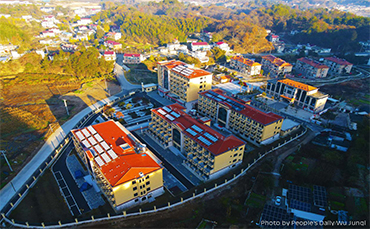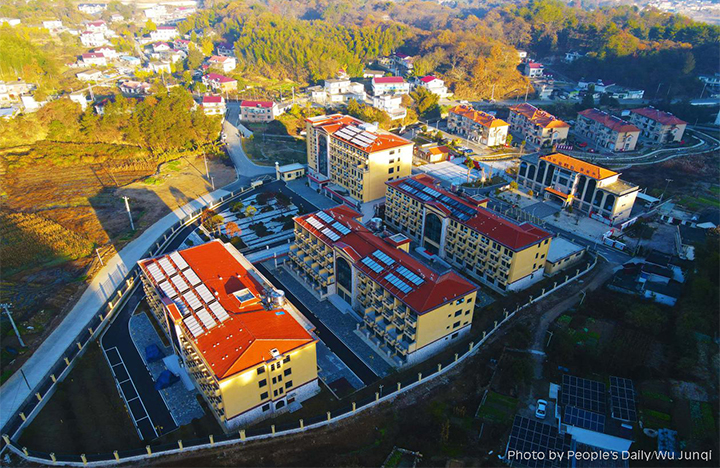



▲ Photo shows the Fumanyuan eldercare center in Shiqiao community, Tiantang township, Yuexi county, Anqing, Anhui province. [People's Daily/Wu Junqi]
3. Regulate Construction Requirements
3.5 Promote the revitalization and utilization of social stock resources.
Vigorously optimize and integrate community-supporting buildings and other public spaces, clean up non-essential and unreasonable uses, and prioritize the use of vacated resources for the development of community-level embedded services. Accelerate the leasing and transfer of social stock resources such as closed factories, warehouses, collective houses, commercial facilities, etc. around the community. For parks, buildings, schools, properties, and land not in line with the direction of urban development, closed and inefficient, and dilapidated and uncared for, can be used to revitalize and redevelop for community-level embedded services by relevant regulations. Support and guide government organs, enterprises, and public institutions to active idle buildings and facilities to provide staff canteens to the surrounding communities, and achieve common construction and sharing.
3.6 Improve a sustainable construction and operation model.
Select a reasonable and sustainable service model based on residents' needs, market supply, and financial capacity. Provide low-cost facility construction sites to service operators through market-based selection, entrusted operation, etc. Service operators should provide community services and other public welfare services at affordable prices. Explore the chain and custodial operation of professional institutions for community-level embedded service facilities, and establish a "subdistrict-community-residential compound" service system. Encourage various entities such as public institutions, social organizations, and volunteer teams to participate in the operation. And guide community property and housekeeping companies to provide services that deliver benefits to all.
3.7 Increase the supply of high-quality community services.
Relying on the construction of urban community-level embedded service facilities while implementing actions to build a better life in urban communities. Support all localities in building many “frontrunners” enterprises and service brands in the fields of elderly care, community-supporting catering, household convenience services, etc. Actively foster community-integrated services and specialized service operators. Improve the informatization of community-level embedded services and promote the integrated development of online and offline community services.
4. Strengthen Supporting Facilities.
4.1 Coordinate construction funding channels.
Actively broaden the funding channels through the coordination of investment from the central government budget and local government budget, as well as the social capital, etc. Combined with the implementation of renovation of old urban residential communities, increase the support for the construction of community-level embedded service facilities. Include eligible projects of community-level embedded service facilities into the list supported by local government special bonds. Give full play to the role of all kinds of financial institutions to provide support for eligible projects of community-level embedded service facilities according to market-based principles. Encourage financial institutions to support inclusive loans to the projects of community-level embedded service facilities and service operators that meet the re-lending policy requirements for elderly care and micro and small businesses.
4.2 Streamline the procedures for project approval and registration and record of service enterprise.
The National Development and Reform Commission should organize the formulation of the Guidelines for the Construction of Urban Community-level Embedded Service Facilities to guide all localities in delivering projects. Community-level embedded service facilities should carry out safety assessments and construction of safety facilities when selecting locations and arranging layouts. Allow pilot cities to relax or simplify requirements such as site area in light of the local conditions after scientific assessment and demonstration, and to formulate local construction standards. Encourage the integration of projects within the jurisdiction of urban areas, subdistricts, and other administrative areas as the basic unit, and carry out preliminary work in a unified manner. Improve the policies of the industry's access for community-level embedded service institutions, streamline related license approval procedures, clarify the processing time limits and announce to the society, and provide convenient and standardized registration, licensing, and recording services for business entities by the law.
4.3 Strengthen policy support for planning, construction, and land use.
All localities should take into account the construction needs of community-level embedded service facilities when formulating territorial master planning and detailed planning, and promoting the construction of urban-rural community service systems. In combination with the renovation of old urban residential communities, the pilot construction of full-featured communities, the construction of community life circles, the construction of 15-minute convenient life circles, etc., public service land for community-level embedded service facilities should be rationally allocated.
The government-constructed community-level embedded service facilities area non-profit public service facilities and are allowed not to change the original land use within 5 years. Encourage the renewal and compound use of land that has not been fully utilized, allow the splitting and merging of plots in the same block, and streamline the procedure of rural land circulation. The renovation projects of community-level embedded service facilities that utilize the stock of buildings approved by the people’s government at or above the county level could enjoy the supportive policy for land ownership, landusright, and planning conditions to remain unchanged within 5 years. Allow the people’s government at or above the county level to streamline the procedures for acceptance checking and recording for the fire control facilities of community-level embedded service.
Source:
<https://www.gov.cn/zhengce/content/202311/content_6917190.htm>
<http://en.people.cn/n3/2023/1202/c90000-20105163.html>
Edited and Translated by Guo Xinxin